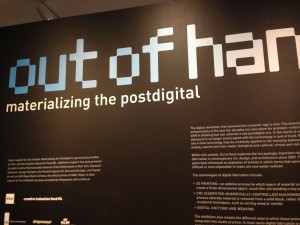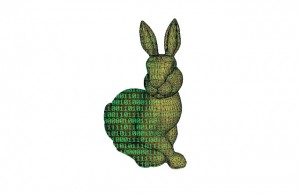On a recent visit to Out of Hand: Materializing the Postdigital, an exhibition about digital fabrication at New York’s Museum of Art and Design, I was struck by the ways in which these new tools had replaced traditional materials and processes on the small, white rectangular museum labels. More specifically, in this exhibition, digital fabrication tools such as 3D printing, CNC (computer-numerically-controlled) machining, laser cutting, and digital knitting and weaving—and, more importantly, complex combinations of these tools—took the place of traditional art and design methods such as painting, etching, collage and sculpture. According to the show’s curator Ron Labaco, “In the world of art and design, discourse is not longer preoccupied with the technology in and of itself. Rather, interest lies in how technology may be creatively applied in the interplay between digital and analog, natural and man-made, biological and cultural, virtual and real.”
The exhibit, which is believed to be the first of its kind, showcased examples of digital fabrication from fashion, furniture and sculpture since 2005 including works by Zaha Hadid and Anish Kapoor. As such, it is a fitting place to begin a discussion of the hybrid nature of digital materiality and digital aesthetics. Digital materiality, which might be defined as the inherent materiality of digital things as well as the embedded digitality of material things (Blanchette, 2011; Dourish & Mazmanian, 2011; Leonardi, 2010; Orlikowski, 2007), has become a particularly useful notion to counter discourses around the immateriality of the digital world.
Such discourses are easily found within certain strands of academic scholarship, widespread mainstream media accounts as well as within depictions from science fiction films about the Internet such as The Matrix, and, even more recently, in The Fifth Estate, a dramatization about WikiLeaks. In The Fifth Estate, Julian Assange and his colleagues are repeatedly depicted basking in the green glow of computer code while crouched over a computer at a desk set in a vast, placeless panorama of thousands of unembodied computers. Such visual metaphors do little to overturn common understandings of the immateriality of digital systems.
At the same time, scholars in communications and science and technology studies have widely acknowledged that we are living in a world of hybrids that collapse and transcend traditional categories such as digital/material, public/private and human/non-human to name just a few. In this essay, the notion of digital materiality as the embedded digitality of material things is particularly useful in light of examples around digital fabrication and the so-called ‘internet of things’. Yet, this hybrid theoretical concept requires additional specificity around its material and aesthetic properties. For example, how are the digital and material aspects temporally and spatially distributed and organized? Who is participating in the production of such examples? And, what is the gendered nature of the participation?
With respect to digital fabrication tools, they can be understood to have embedded values and affordances while at the same time a flexibility that allows them to be appropriated and used for any manner of creative pursuits. Yet, why are some of the most quintessential and oft-cited examples of 3-D printing related to Defense Distributed’s politically-charged printing of a gun along with its values of revolution and defense of civil liberty (discussed in Matt Ratto’s earlier post) while laser cutting is deployed to produce seemingly apolitical, decorative cut-outs for Salvatore Ferragamo’s luxury handbags and Crate and Barrel’s table placemats? These two polarized examples illustrate the ways in which certain politics, materialities and modes of participation are privileged over others.
They also raise important questions about what is meant by the so-called democratization of making and participation in the 21st century. For example, is the making and participation in emergent forms of peer-to-peer production that happens at a hackerspace around the 3D printed gun akin to the making that occurs when a fashionista curates a Pinterest board of laser cut dresses. Or, is the fashionista merely an aspirational consumer of a superficial cultural industry as many would dismiss her to be? In fact, I would argue that she is in fact a maker: of tastes, aesthetics and communities. (However, glorifying the role and agency of the maker is itself a perpetuation of the libertarian values of Silicon Valley and the self-reliance of the American frontier mindset).
In May 2011, new media artist James Bridle announced a Tumblr blog about an ongoing research project called the “The New Aesthetic.” According to Bridle, the blog features “material which points towards new ways of seeing the world,” which the current examples of 3D printing and laser cutting are no doubt a part. Bridle’s examples are described as “something designed for network culture to take up: for him, the products are ‘unknown,’” (Berry et al., 2012, p. 17). According to media theorist Ian Bogost, a leading advocate for object-oriented ontology, The New Aesthetic does not go far enough in its ambition because it is primarily concerned with computation and digital things.
Especially with respect to emerging technologies that may not have any ‘users’ to study from a social scientific perspective, art and design examples provide valuable empirical evidence that can shed light on complex theoretical questions such as digital materiality. In this way, artists and designers can be understood as a kind of lead user or early adopter of emerging technology, and their experiments with digital fabrication tools are helpful in understanding and specifying the material and aesthetic properties of the digital. Furthermore, methods such as critical design (Dunne, 2001), critical making (Ratto, 2011), speculative design (DiSalvo, 2012) and design fiction (Bleecker, 2009) offer opportunities for social science to engage with emerging technologies and associated socio-technical issues that are outside of the scope of a traditional research project. As such the critical and analytical rigor of the social sciences can be integrated with the generative and future-oriented capabilities of the field of design.
In this spirit, last Spring, I co-taught a class on digital fabrication with product designer Martin Thaler at the Institute of Design at Illinois Institute of Technology in order to explore the new possibilities and constraints of these tools for the work of designers. The course sought to: 1) understand and experiment with digital fabrication tools (specifically, the 3D printer and laser cutter) in order to determine when, how and why they may be useful in the design process; 2) demonstrate them through actual experience using them to make prototypes; and, 3) educate the Institute of Design community on their use. The projects explored a range of themes including digital aesthetics and digital materiality; peer-to-peer collaboration, do-it-yourself communities and maker cultures; and, sustainability through re-making.
I will briefly mention three of the projects that resulted from the course in order to expand on our current understandings of the digital materiality afforded by digital fabrication tools. First, Co-Rabbit by Drew Raines, brought together concepts related to codesign, peer-to-peer production and the ‘internet of things.’ While conceived as a platform that would allow any member of the Institute of Design community to model and print their own unique rabbit as part of an extended genealogy originating from one original model, the complexity of instructions and considerations necessary to enable another graduate student (even one with a strong background in design) quickly became apparent. This project revealed the incredible time and knowledge intensity apparent within a 3D modeled and printed object in contrast to the revolutionary, mainstream accounts of the ease of use of digital fabrication tools. In this example, digital materiality might be understood in temporal terms as a representation of the intensity of human and material resources.
Second, Mold-IT by Paulina Carlos, used 3D printing in order to create a mold into which to pour silicon, which then could be used to hold a ring inside a box. In this case, 3D printing was used to validate the size, shape and dimensions of the mold. In this example, digital materiality might be understood in spatial terms as a representation of scale, form and dimensions as they are prototyped in the digital modeling software and output in physical form.
Finally, “Am I going to get blamed for breaking the MakerBot?” by John Trotti, used 3D printing to output a series of small, human heads that could be used as mediating artifacts for the purposes of communication and dispute resolution. In this project, the 3D printer’s embedded property of precision and accuracy (however imperfect) was an obstacle to the creative use of the tool.

Image credit: John Trotti
While the projected aimed for an output with a more organic quality, Trotti found that it was difficult to print something that looked more like spaghetti than a solid, geometric object. In this example, digital materiality might be understood in terms of organic and non-organic qualities as well as qualities such as opacity and transparency.
In closing, digital fabrication tools are important sites of sociotechnical practice that allow for the unpacking of theoretical concepts related to digital materiality and digital aesthetics, understood as both the materiality of digital things as well as the reverse. As theorists and social scientists, it is important to go beyond current notions around hybrids and begin to specify and reveal the material and aesthetic properties inherent such entities. Art and design projects offer insights into digital materiality that are not easily accessed through other forms of empirical investigation. This essay has used current design projects that use digital fabrication tools in order to discuss the ways in which 3D printed artifacts exhibit a kind of digital materiality that is manifested temporally and spatially and which takes on qualities such as organic/non-organic or opacity/transparency. This specificity is necessary in order to achieve a deeper understanding of what we mean by hybrids of all kinds. Without it, hybrids themselves become reifications that hesitate to move beyond simplistic notions of digital/material, public/private and human/non-human.
Berry, David M., van Dartel, Michel, Dieter, Michael, Kasprzak, Michelle, Muller, Nat, O’Reilly, Rachel, & de Vicente, Jose’ Luis. (2012). New Aesthetic, New Anxieties. http://v2.nl/publishing/new-aesthetic-new-anxieties
Blanchette, Jean‐François. (2011). A material history of bits. Journal of the American Society for Information Science and Technology, 62(6), 1042-1057. http://onlinelibrary.wiley.com/doi/10.1002/asi.21542/abstract
Bleecker, J. (2009). Design Fiction: A short essay on design, science, fact and fiction. . http:// www.nearfuturelaboratory.com/2009/03/17/design-fiction-a-short-essay-on-design-science-fact- and-fiction/
DiSalvo, Carl. (2012). Spectacles and Tropes: Speculative Design and Contemporary Food Cultures. The Fibreculture Journal (20). http://twenty.fibreculturejournal.org/2012/06/19/fcj-142-spectacles-and-tropes-speculative-design-and-contemporary-food-cultures/
Dourish, Paul, & Mazmanian, Melissa. (2011). Media as Material: Information Representations as Material Foundations for Organizational Practice. Paper presented at the Third International Symposium on Process Organizational Studies, Corfu, Greece.
Dunne, Anthony. (2001). Hertzian Tales: Electronic Products, Aesthetic Experience, and Critical Design. Cambridge, MA: MIT Press.
Leonardi, Paul M. (2010). Digital Materiality? How artifacts without matter, matter. First Monday, 15(6). http://firstmonday.org/ojs/index.php/fm/article/view/3036/2567
Orlikowski, W. J. (2007). Sociomaterial practices: Exploring technology at work. Organization Studies, 28(9), 1435-1448.
Ratto, M. (2011). Critical Making. In P. Atkinson, Avital, M., Mau, B., Ramakers, R., & Hummels, C. (Ed.), Open Design Now: Why Design Cannot Remain Exclusive. BIS Publishers. Amsterdam: BIS Publishers. http://opendesignnow.org/index.php/article/critical-making-matt-ratto/


